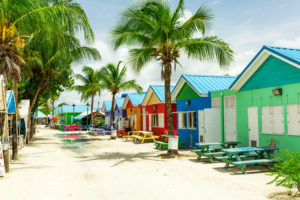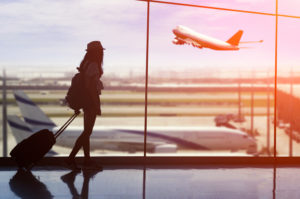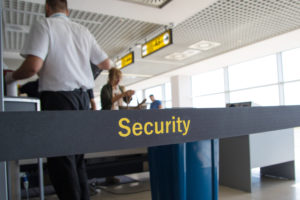While testing is now required for all international travel into the U.S., traveling domestically is mostly unrestricted. However, there are states that have either a suggested or mandatory quarantine period for out-of-state visitors.
Testing Out of Quarantine When Traveling Domestic
If you’d like to reduce or eliminate the time you’re required to quarantine, the following states have a testing protocol you can follow in order to do so. Sometimes these testing requirements only apply to specific counties or cities, while most of the states listed below have statewide policies.
Essential workers are generally exempt from testing and quarantine requirements, and travelers from bordering states are often excluded as well. Even though it may not be required, the CDC recommends that all travelers take a test within 3 days of departure and again 3-5 days after arrival.
Alaska
All travelers entering Alaska must fill out a Travel Declaration form. You can either arrive with proof of a negative molecular test for SARS CoV-2 within 72 hours of departure or take one upon arrival in Alaska. Non-residents of Alaska must pay $250 for this test so it is best to find a cheaper one before your departure. Residents of Alaska can take the test upon arrival for free, but must self-quarantine until results arrive. Bottom line, it’s best to get a test before you fly.
A second test is optional, but recommended 5-14 days after arrival. If you’ve had a positive molecular-based test for COVID-19 in the past 90 days, have recovered, and no longer show any symptoms, Alaska will accept this in lieu of a negative test as long as you can show proof and a note from a medical provider or public health official stating that you have been released from isolation. For the most up-to-date information, read the Safe Travels page on the State of Alaska’s COVID-19 information site.
Colorado
While there isn’t a statewide testing requirement for Colorado, Pitkin County, which includes popular ski resorts in Aspen and Snowmass, requires travelers staying overnight in the county to complete a Traveler Affidavit. Anyone 10 years old and above must have proof of a negative viral test taken within 72 hours prior to arrival. If you arrive without a test, you must take one at your own expense upon arrival and quarantine until you get a negative result. A 10-day mandatory quarantine is in place if you fail to produce a negative test result.
Connecticut
Before traveling to Connecticut, you must fill out a health form unless you are coming from New York, New Jersey, or Rhode Island. Travelers are required to quarantine for 10 days upon arrival unless you provide proof of a negative COVID-19 test that was taken within 72 hours prior to arrival. The results must be emailed to the Commissioner of Public Health at DPH.COVID-Travel@ct.gov. All tests other than antibody tests are accepted. For the most up-to-date information, check the Connecticut COVID-19 Response portal.
Hawaii
Due to its geographic location, Hawaii has been able to implement a stricter quarantine and testing protocol than states on the mainland. And to complicate things even more, Kauai has a more stringent policy than other islands. Hawaii requires a 10-day mandatory quarantine for travelers from out-of-state unless you participate in the pre-travel testing program.
If you’re traveling to Hawaii and want to avoid the mandatory quarantine, follow these steps.
- Sign up and create a Safe Travels user account for each adult at travel.hawaii.gov.
- Enter your trip details for each leg of travel.
- Upload your COVID test result taken within 72 hours from the final leg of travel.
- Fill out a health questionnaire, which is available 24 hours before your departure.
- Obtain a QR code from your email, which will speed up the process at the airport.
Important: You must have a negative result either uploaded to Hawaii’s Safe Travels program or printed in-hand before you board your flight to Hawaii in order to qualify for the pre-travel testing program. Also, Hawaii only accepts a Nucleic Acid Amplification Test (NAAT) taken from a certified Clinical Laboratory Improvement Amendment (CLIA) lab by one of its trusted testing and travel partners.
The island of Kauai has a unique policy that still requires a modified 72-hour “Enhanced Movement Quarantine” in addition to participating in the pre-travel testing program. If you fly directly to Kauai from out of state, you can stay at an approved “resort bubble” location where you are able to use the hotel’s amenities, such as the pool and on-site restaurants, but cannot leave the property until you receive a second negative test taken more than 72 hours after arrival.
Alternatively, you can choose to fly directly from the mainland to a neighboring island, stay for at least 72 hours to qualify as an interisland traveler, and then take another test before you hop on a short interisland flight to Kauai. This is the best option for visiting Kauai if you don’t want to be restricted to staying at specific county-approved resorts.
For the most up-to-date information on Hawaii’s travel guidelines, keep an eye on the State of Hawaii’s Department of Transportation coronavirus page.
Illinois
Illinois does not have a state-wide order to quarantine for out-of-state visitors, but the city of Chicago has its own mandatory 10-day quarantine if you are traveling from an “orange” state, which is a state with more than 15 average daily cases per 100,000 residents. At the time of writing, all states except Hawaii fall in this category, but check here for any updates.
Travelers to Chicago can take a pre-arrival test no more than 72 hours prior to arrival and have proof of a negative result to avoid the mandatory quarantine.
Kansas
Kansas requires a quarantine for travelers from out-of-state who have attended mass gatherings or events of 500 people or more. The Department of Health website states that the quarantine also applies to anyone who has been on a cruise ship or river cruise on or after March 15 or anyone who has received notification from a public health official that they are a close contact of a confirmed COVID-19 case.
The 10-day quarantine can be reduced to 7 days with testing. On Day 6, you can take a PCR test, and if you get a negative result and remain symptom free, you can leave on Day 8, after a full 7 days of quarantine.
Maine
If you travel to Maine, you must quarantine for 10 days unless you take a test and receive a negative result within 72 hours of arrival. Fill out the travel protocol form before you arrive and present the certificate of compliance to your place of lodging. Tests can also be taken once you arrive in Maine, but you’ll need to stay isolated until you receive the negative result. Residents of New Hampshire and Vermont are exempt from the testing protocol. For the most up-to-date information, check Maine’s COVID-19 response page.
Maryland
Unless you’re traveling from Delaware, Pennsylvania, Virginia, West Virginia, or Washington D.C., you’ll be required to self-quarantine for 10 days or have a negative test result taken within 72 hours of arrival when traveling to Maryland. For the latest information, read Maryland’s Roadmap to Recovery.
Massachusetts
Anyone traveling to Massachusetts must fill out a travel form prior to arrival if you’re arriving from a restricted state. At the time of writing, this includes all states except Hawaii. Travelers from a restricted state must quarantine for 10 days or bring proof of a negative test taken within 72 hours prior to arrival.
New Hampshire
If you’re traveling to New Hampshire from outside of New England (Maine, Vermont, Massachusetts, Connecticut, and Rhode Island), you’ll need to quarantine for 10 days. You can test out a few days early if you’re not showing any symptoms by taking a negative PCR test on or after day 7.
You are also exempt from the quarantine if you are fully vaccinated and more than 14 days have passed since your second dose or if you’ve tested positive within the last 90 days and have proof of recovery.
New York
All travelers to New York state must fill out a Traveler Health Form before leaving the airport or be subject to a steep $10,000 fine. If you are entering New York from a non-bordering state and were out-of-state for more than 24 hours, you can reduce the mandatory 10-day quarantine by following these steps.
- Take a test within 3 days of departure, prior to arriving in New York.
- Quarantine for 3 full days upon arrival in New York.
- On day 4, you can take another test and leave quarantine if both tests are negative.
Pennsylvania
The Department of Health requires all travelers entering Pennsylvania to have a negative COVID-19 test taken within 72 hours prior to arrival or quarantine for 10 days. The test can be taken upon arrival, but you must quarantine until you receive a negative result. For the most up-to-date information, go here.
Rhode Island
If you are traveling to Rhode Island from a state with a positivity rate above 5%, then you’ll be required to self-quarantine for 14 days unless you provide proof of a negative test taken within 72 hours prior to arrival. The Rhode Island Department of Health keeps a list of these restricted states here.
Vermont
Like its neighbor in New Hampshire, Vermont also has a mandatory quarantine for out-of-state travelers. If you are traveling in a private vehicle, you can complete a 14-day self-quarantine or a 7-day quarantine followed by a negative PCR test in your home state before driving to Vermont.
If you are traveling to Vermont by public transportation (airplane, train, or bus), you must quarantine in Vermont. The 14-day quarantine can be reduced to 7 days if you are asymptomatic and obtain a negative PCR test after your 7th day. For the most up-to-date information, visit the Health Vermont visitor’s page.
States That Recommend A Quarantine When Traveling
There are several other states that strongly suggest a quarantine when traveling from out-of-state, but fall short of a state-wide mandate. California, Kentucky, Minnesota, New Jersey, Ohio, Oregon, and Washington all fall in this category. New Mexico requires a 14-day quarantine when traveling from high-risk states, but does not offer any way to test out in order to shorten or eliminate this rule.
Other states may not mention a specific quarantine at this time, but all states are encouraging everyone to keep wearing masks, avoid crowded indoor spaces, and wash hands frequently to help mitigate the spread of the coronavirus. As always, make sure to consider CDC guidelines when traveling and stay up-to-date on any restrictions both in your home state and your destination.






